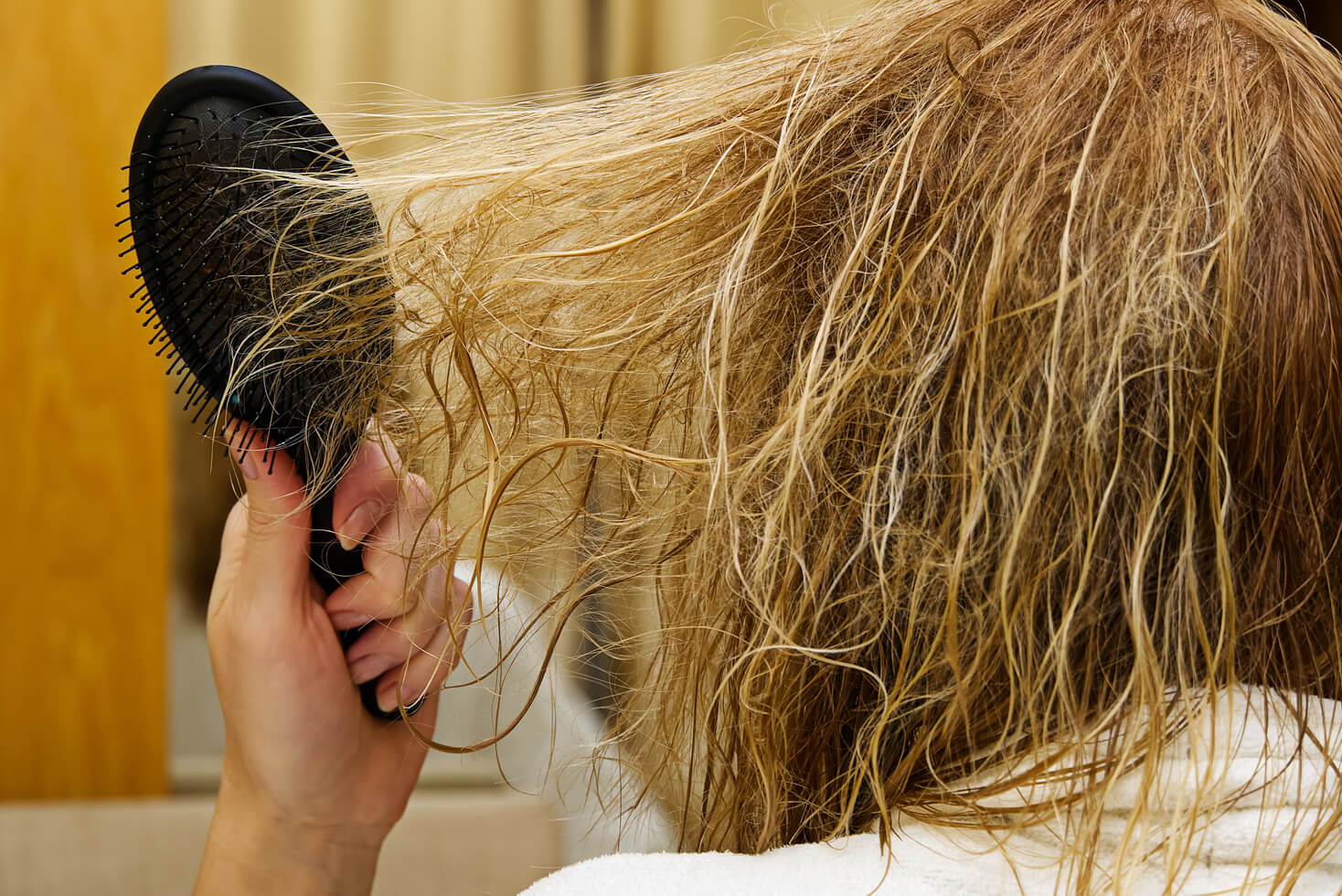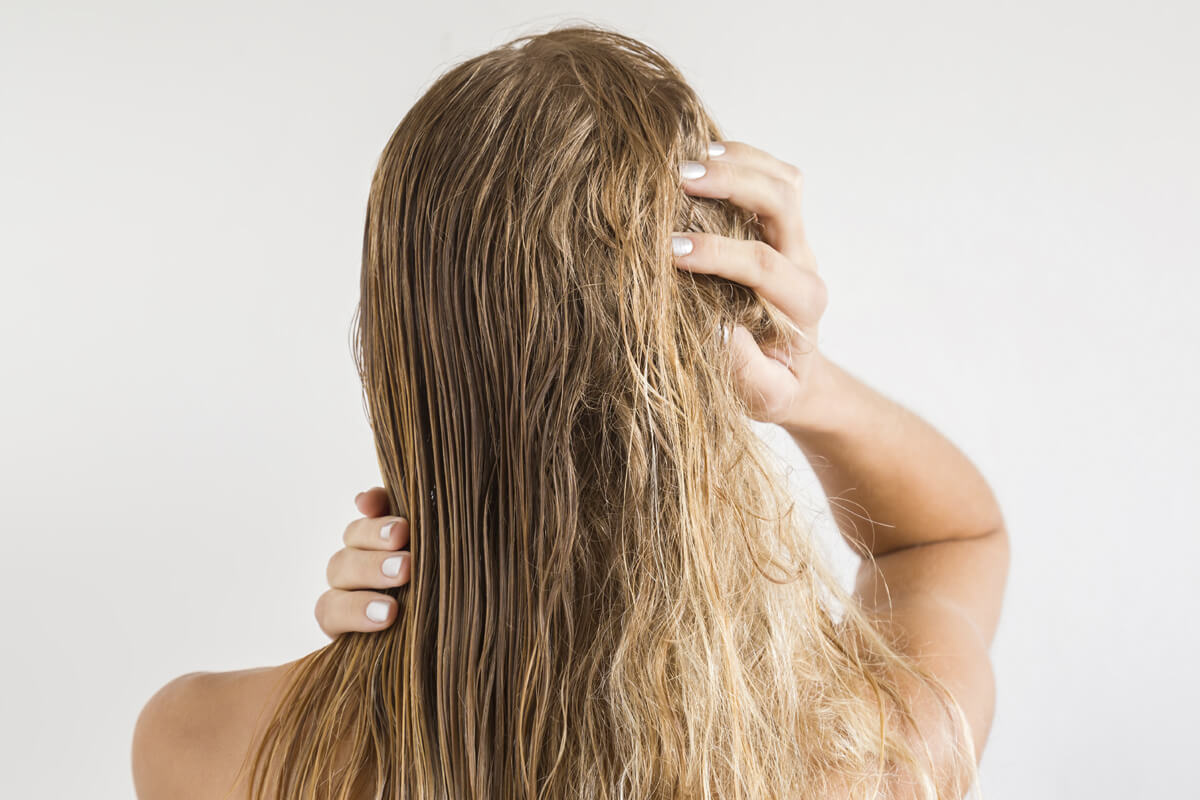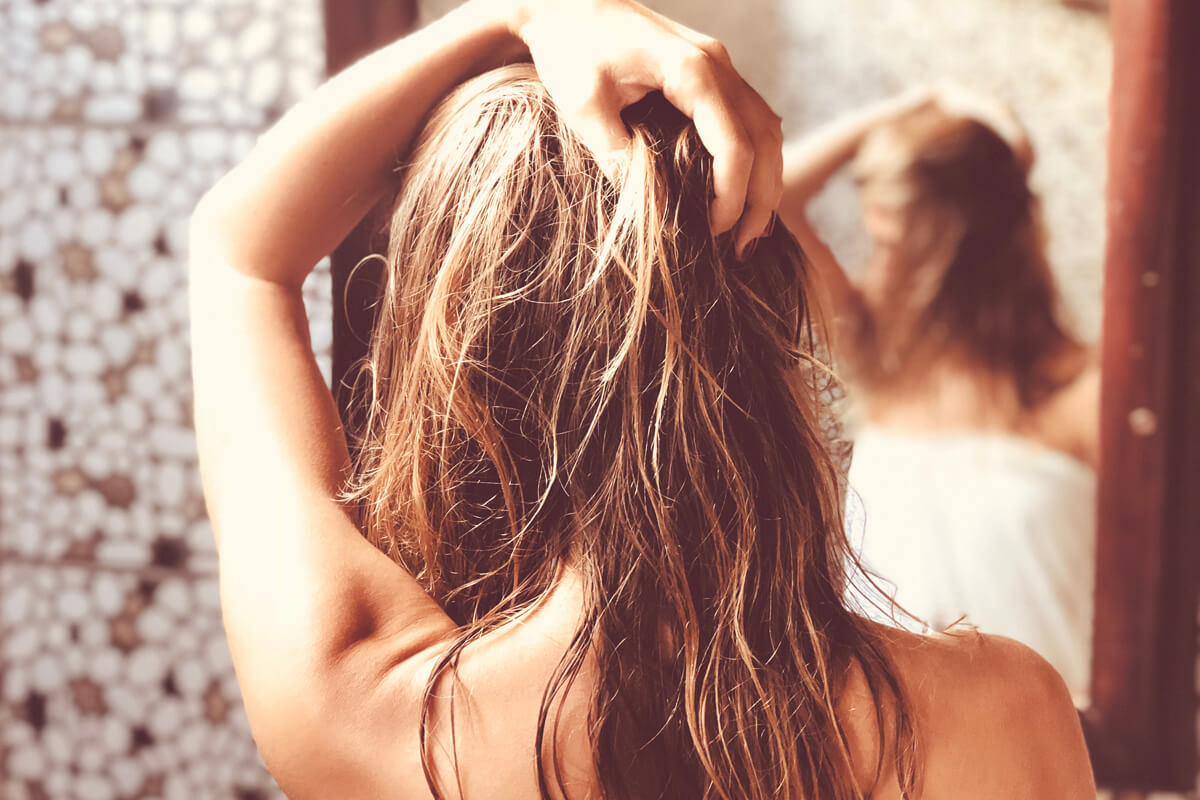Unraveling Wet frizz – Why Does Hair Get Frizzy When It’s Wet?
Updated on
This post may contain affiliate links. As an Amazon Associate, we may earn from qualifying purchases.

On washdays, it’s normal to experience a little frizz as your hair starts to dry. But when frizz takes over on soaking wet hair, even when it’s saturated with conditioner, you know you’re in for a tedious washday.
So why does hair get frizzy when it’s wet, and how can you avoid it?
Read on to unravel the mystery behind wet frizz and find out what you can do to hop out of the shower with low-maintenance, smooth, and frizz-free hair.
Table of Contents
- What is Wet Frizz?
- Why Does Hair Get Frizzy When Wet?
- What Does Wet Frizz Look Like?
- Types of Wet Frizzy Hair
- How to Get Rid of Wet Frizz
- Clarify Your Hair Weekly
- Change Your Hair Products
- Get The Right Shampoo
- Use a Good Anti-Frizz Conditioner
- Mix Water With Your Conditioner
- Use a Wide Tooth Comb to Detangle in The Shower
- Add Styling Product to Wet Hair
- Dry Your Hair With Care and Avoid Flash Drying
- Let Your Hair Air Dry
- Try the Curly Girl Method
- For Curly Hair – Curl Your Clumps With the Plump Method
- Deep Condition Weekly
- Try a Protein Treatment
- Best Products for Wet Frizz
- Frequently Asked Questions About Wet Frizz
- Wet Frizz Can Be A Sign of Hair Damage
What is Wet Frizz?

Wet frizz is a type of frizz that occurs when the hair is still wet. Regardless of hair type, it typically occurs after washing, rinsing out conditioner, or when you’re wringing out excess water to dry your hair.
Unlike dry hairs that tend to that stick out and divert from the natural pattern, wet frizz makes the hair appear stringy and gooey with uneven curl clumps. You’ll notice that some strands dry faster than others to cause flyaways.
The problem with wet frizz is that you know your whole head will be frizzier once it dries. So it’s essential to mitigate the frizz before you even start drying your hair.
Although it’s reasonable to experience a small amount of frizz when the hair gets wet, having too much can be a sign of underlying problems with the condition of your hair or your hair care routine.
Why Does Hair Get Frizzy When Wet?
Hair reacts to water and moisture in many different ways. It can stretch, swell, or shrink. Wet frizz can be attributed to the natural shape-shifting of the hair, but in most cases, it’s directly related to the poor condition of the cuticle layer.
Below is a list of the most common causes of wet frizz:
Water Expands the Hair’s Cuticle Layer
A healthy hair strand will change shape when it’s wet. It can stretch up to 30% of its original length without damage and 12-18% in weight. But when a hair strand is damaged, gaps on the cuticle layer allow more water to pass through. As a result, the hair shaft stretches and swells beyond its natural limit, eventually buckling past the cuticle. When this happens, the expansion lifts the hair cuticle scales away from the axis of the hair, making the surface rough and prone to tangling [2] instead of nesting and clumping together properly.
“The hair’s cortex is made up of keratin fibers and temporary bonds that are scattered in different patterns to create various hair textures. These hydrogen-based bonds break as soon as water touches strands, and that causes hair to unfold and elongate.” Prose Hair Care
Dry Hair – Lack of Moisture
When your hair is too dry, it will voraciously soak up any type of moisture around it. By trying to compensate for the lack of hydration, dry hair tends to absorb moisture in excess, causing water molecules to disrupt the hydrogen bonds within the inner structure. This again causes swelling that forces the cuticle layer to distort and become rough and frizzy.
Related: Definition and characteristics of frizzy hair.
Damaged Hair
Wet hair is weaker than dry hair in tensile strength. That’s because water breaks the hydrogen bonds within to make the hair unfold and elongate. Being more malleable and easy to style when damp also makes the hair vulnerable to breakage where damage has already occurred. For example, hair damaged from heat styling or chemical treatments has more fragile structures that can be overwhelmed by the excess swelling.
Compared to healthy hair, which can expand by 30% of its length, damaged hair can stretch between 30% to 70% causing irreversible changes. These changes are known as weathering of the hair – a main contributor to excessive tangling and frizzing even when the hair is wet.
High Porosity Hair

Hair porosity measures how well your hair can absorb and retain moisture. Hair porosity highly depends on the condition of the cuticle layer of the hair shaft. It’s called low porosity when it’s tightly packed and has no gaps. When the cuticle layer has loose scales, gaps, and cracks along the surface, it’s called high porosity. Medium porosity hair is the least problematic as the cuticle layer is healthy and responsive.
When the hair is highly porous, it traps water to keep things damp for longer. As a result, high porosity hair takes longer to dry and stays in an expanded and stretched state for much longer, contributing to tangling and wet frizz like webbing.
Buildup
Buildup is the accumulation of styling hair products, dirt, and environmental elements that stick to the hair and don’t rinse out completely. For example, gels, leave ins, oils, hard water minerals, sebum, and so on. Over time, these leftovers coat the hair strands to create an obstructive barrier to moisture, meaning your moisturizing products are simply sitting on top rather than soaking into the hair. Buildup prevents conditioners from working properly, hence why it’s unable to smooth out and eliminate frizz when washing.
So check for signs and symptoms of buildup in your hair to see if it may be the culprit.
Hard Water
Another common cause of frizzy hair is hard water that contains high levels of minerals such as calcium, magnesium, iron, and chlorine. These minerals continuously deposit and accumulate onto the hair and scalp over time. The problem with hard water is that a regular shampoo cannot break down and rinse out the mineral deposits. You’ll need a hard water demineralizing shampoo to neutralize the mineral buildup from the hair and scalp.
If you’re not using a hard water shampoo, you most likely have mineral buildup in your hair that’s roughing up the cuticles and blocking essential moisture.
Another big problem with minerals-heavy water is that it’s highly alkaline for the hair. That means it changes the pH balance – a critical mechanism of the human body that keeps it healthy and in good harmony.
In short: Depending on where you live, your water could be doing a number on your hair by causing buildup that contributes to wet frizz.
Improper pH
The acidity (low pH) of our hair is natural, and the objective is to keep the pH low so that the cuticle cells stay closed. Shampoo is typically more alkaline in nature. Therefore it occupies a higher place on the pH scale. It’s intended to gently lift the cuticles to wash away grime and styling products that have accumulated between gaps. However, shampoos can’t close down the cuticles once the deep cleansing is done.
If you swing the pH to the other extreme (alkaline), the cuticle layer will flare up, loosening the scales. That’s why alkaline elements increase negative electrical charges on the hair, increasing friction and frizz.
To counteract the alkaline effect, you’re advised to use a conditioner straight after shampooing. Conditioners are formulated to rebalance the pH of the hair after washing. A conditioner effectively lowers pH, which forces the cuticle scales to flatten down. Hence the smooth and shiny hair.
Look for a gentle shampoo formulated at lower pH for hair and scalp to keep your hair in its pH range.
Protein Overload
Protein is good for the hair as it helps to strengthen the inner structures and preserve elasticity. But too much of it can have the complete opposite effect. A protein overload can make your hair feel dry, stiff, and bloated.
It’s important to have a good balance of moisture and protein in the hair. Lack of protein will make your hair feel limp and mushy, while too much protein will make your hair feel stiff and heavy when damp.
A protein treatment like keratin is highly recommended every 3-4 months. It provides the optimal balance of protein and other hair boosters like collagen, amino acids, and antioxidants to rejuvenate and repair the hair.
Improper Moisturizing
If your hair is not drying out fast and holding on to water for longer than expected, then it’s a sign that you’re not moisturizing enough.
When washing your hair, it’s essential to avoid leaving your hair in a wet and fragile state for too long, as this is when it’s more likely to become frizzy.
Using the Wrong Shampoo
Many shampoos contain harsh detergents like sulfates that dry out the hair. Use shampoos that don’t contain sulfates; for example, the Redken Frizz Dismiss is one of the best for unruly frizz.
What Does Wet Frizz Look Like?
Most people who experience wet frizz would describe it as hair that is soaking wet but still appearing as dry in parts.
Below are a few examples of what wet frizz may look like:
Stringy, Mushy, and Gooey Looking Hair
With this type of frizz, the hair feels dry even when wet. You’ll find sections that stick together, and some sections cannot form uniform clumps.
Overall, it’s a messy texture of frizzy curls that’s hard to tame and style.
Frizz Webbing
Frizz webbing is a condition that causes wet hair to look dry and frizzy, often resulting in an unruly tangled mop of hair. Curly and wavy hair types are more prone to webbing as the curls won’t clump in a uniform manner until you try to brush or comb out the knots. The best way to avoid this is by using a wide-toothed comb or a detangling brush on soaking wet hair, gently combing through from the bottom up.
For a more visual explanation, I recommend this awesome video by Gema Marie on wet frizz and hair webbing.
Types of Wet Frizzy Hair

Wet frizz can show up in many different ways, depending on your hair texture and condition. Below are the most common types of frizz that affect damp hair.
Frizzy Roots
Frizzy roots occur when the hairs closer to the scalp adopt a fluffy and puffy texture, creating an underlayer frizz. This usually happens because of a dry scalp or breakage near the roots.Spider Web Frizz
This type of frizz usually happens near the mid-lengths and ends of the hair, where individual strands wrap up around each other to create a spider web effect. People usually describe this as frizz webbing.
How to Get Rid of Wet Frizz
Here are some tips to help you get rid of wet frizz and help your hair retain moisture for longer.
Clarify Your Hair Weekly
Before you start with any products, the first thing to do is make sure your hair is in a clean slate. Start with a deep cleansing shampoo to remove any lingering buildup or residues that may be obstructing your hair strands from absorbing moisture.
Related:
Change Your Hair Products
Do a process of elimination. You may be overdoing it or using the wrong hair products, so your hair seems a bit confused. I’ll say drop everything and start by adding them one by one and keep an eye on how your hair responds.
Look for anti-frizz products. There’s a whole range that caters to every type of hair. From shampoos to serums and anti-humidity sprays, you can find a product that can reduce and eliminate frizz at every stage of your hair care routine.
Get The Right Shampoo
Could it possibly be your shampoo making your hair frizzy when washed?
Do an experiment by changing your shampoo for one week and see how your hair reacts. Get a shampoo with zero sulfates and ideally formulated at low pH like the Redken Frizz Dismiss.
Use a Good Anti-Frizz Conditioner
Add more water and conditioner if you see frizz in your wet hair.
Conditioners are acidic and intended to seal the cuticle layer and minimize wet frizz. Unless you’re going to use a deep conditioner as a follow-up, don’t skip the conditioner.
Mix Water With Your Conditioner
First, to fix wet frizz on curly hair, hydrate your curls by adding more water to your hair. The easiest way to do this is by using your hands to smooth some water on your hair. Your curls should clump together quickly, and have little to no wet frizz. If you’re still experiencing wet frizz, especially at the roots, finger coil the unruly curls after adding water. To fix wet frizz, it’s also crucial that you follow a moisturizing curly girl routine.
Use a Wide Tooth Comb to Detangle in The Shower
Wide-tooth combs are great for frizzy hair because they have more gaps through which hair can pass, preventing breakage.
Alternatively, you can also use your fingers to gently detangle your hair after washing. Both methods are better than using plastic brushes, which can cause friction and static in the hair.
Add Styling Product to Wet Hair
Tame patchy wet frizz by applying and crunching styling products to damp hair.
This video teaches you how to scrunch without causing wet frizz.Applying styling products to damp allows better absorption and clumping. Plus, styling products coat the hair with smoothing and moisturizing agents that help retain moisture and prevent frizz before the hair starts to dry.
Dry Your Hair With Care and Avoid Flash Drying
Even if you’re using the best products, you can ruin your hair by using improper drying techniques like flash drying. Most people wring their hair out with a towel after washing to save time. Hair gets rough and tangled as a result of this.
Switch to a microfiber towel or a cotton t-shirt and wrap your hair instead. Microfiber towels are made from finer fibers – meaning less friction and snagging on your hair.
Let Your Hair Air Dry
According to hairstylist Joshua Shellhammer, skipping the hair dryer and allowing your hair to air dry can help avoid frizz.
Try the Curly Girl Method
The Curly Girl Method (CGM) is a hair care routine developed by curl expert hairstylist Lorraine Massey.
This routine defines a set of rules to follow and products to use and avoid on curly hair based on texture and porosity. Essentially, it allows you to listen to your hair’s needs and layer the correct products in the right order to optimize your curls and eliminate frizz at any level – be it wet or dry.
So if you have curly hair and struggling with wet frizz and porosity problems, the Curly Girl Method is the right place to start. It will help you eliminate the bad products and incorporate better alternatives that will progressively improve the condition of your curls and eliminate wet frizz from the source.
The CG method is all about feeding your curls with moisture and hydrating them. One rule is to apply a conditioner like you normally do after shampoo but not rinse it completely. Instead, you leave some of it in your hair and use the squish to condish method to ensure your hair is well hydrated to prevent frizz.
Essential CGM Products:
Curlsmith Curly Hair Products
For Curly Hair – Curl Your Clumps With the Plump Method
If you have curly or wavy hair, a common sign of frizziness is when some of your curls refuse to clump with the rest. As a result, you end up with a lack of definition and a confused curl pattern.
When your curls don’t set, they appear scraggly.
Clumped curls fall into bigger patterns, making the hair look healthier with more bounce rather than frizzy and stringy. When your curls don’t clump when wet.
If you have curly hair, your wash day goal is to make your curls clump regardless if you are washing, co-washing, or simply wet refreshing. Curl clumping will give your hair better definition.
You can also use an anti-frizz curl cream for frequent touch-ups on frizzy curls.
Deep Condition Weekly
Make deep conditioning a key part of your hair care routine.
High porosity hair has a “velcro” effect that causes tangles and wet frizz, owing to the high cuticle permeability. A Deep conditioner will make your hair soft and smooth, providing better slip for detangling.
Related:
Try a Protein Treatment
Protein treatments or hydrolyzed keratin treatments help repair damaged hair from within, improving overall tensile strength, elasticity, and the cuticle layer to reduce frizz for up to 5 months. Such treatments also help the hair to stay hydrated for longer without the need to use tons of styling products.
Best Products for Wet Frizz
Redken Frizz Dismiss Shampoo

Olaplex No 3

Olaplex recommends using it once a week. Trust me, it’s so good you’ll feel the difference in the texture of your hair from the first try.
The no. 3 is perfect for the curly girl method as well.
Wide Tooth Comb
To get the best out of your brushing, mix your leave-in conditioner with some water in a spray bottle and saturate your hair completely. Then glide this wide tooth comb to remove knots and tangles with ease. No friction, no frizz.
Aquis Microfiber Towel
Using a microfiber towel can help reduce frizz because microfiber material absorbs water faster than cotton material. As a result, you don’t have to rub the towel on your hair. Just wrap it around your head, and let it soak up all the water.
Microfiber towels are also excellent because the material is ultra-fine. They don’t have rough surfaces like cotton towels that can chip away the surface of the hair when drying.
Frequently Asked Questions About Wet Frizz
Does Wet Hair Cause Frizz?
Yes. Wet hair can cause frizz because the shape of the hair changes as it reacts to water. A hair strand can stretch up to 30% of its original length and 12-18% in weight. The swelling and shape-shifting can create a mix of different textures giving the appearance of frizz until the hair is tamed with anti-frizz styling products for a uniform style and finish.
How Do You Keep Your Hair From Getting Frizzy When Wet?
Use a sulfate-free moisture-rich shampoo to wash your hair and follow up with a good low pH conditioner to rebalance the hair. Style your hair when it’s still damp and use a leave-in conditioner or serum to make sure your hair stays hydrated.
Does Combing Wet Hair Cause Frizz?
Yes, combing wet hair can cause frizz. When hair is wet, it is more fragile and prone to breakage and split ends.
It’s highly recommended to use conditioner when combing wet hair. A conditioner smoothens the surface of the hair by adding slip so that your brush or comb can glide without snagging or pulling.
Can Too Much Conditioner Cause Frizz?
Over-conditioning can cause the locks to be excessively moist and soft, resulting in adhesiveness, stickiness, and loss of natural volume. It may also make your hair weighed down and limp.
Does Sleeping With Wet Hair Cause Frizz?
Sleeping with damp locks might induce a frizzy, tangle, and breakage. It’s preferable to air dry or blow-dry your hair before going to sleep.
Wet Frizz Can Be A Sign of Hair Damage
It’s normal for hair to frizz slightly when washing due to water swelling the hair shaft. But if you experience a lot of wet frizz, it means you may have damaged hair or other conditions like high porosity, which may be exacerbating the condition.
From the list of causes above, identify your major cause and stack up the right products that can neutralize the problem and cut your wash day routine in half.
About the Author
 Camelia Smith
Camelia SmithCamelia Smith can color hair, perform keratin treatments, bleach hair, and even cut curly hair. She is our go-to person whenever we have hair treatments and styling questions.
She's also currently training as a freelance makeup artist and is passionate about helping others feel beautiful in their skin. When she's not writing or doing hair, she's usually spending time watching British period dramas.


